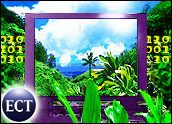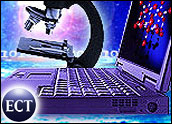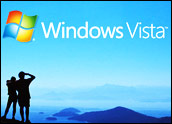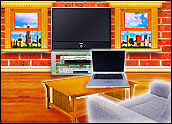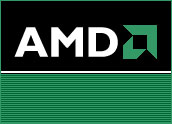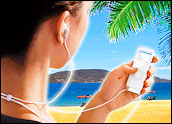
Microsoft on Wednesday unveiled a new technology that lets users control their computers with their feet. Step User Interface is one of more than 150 unique concepts featured at the sixth annual Microsoft TechFest, which is open primarily to company employees, in Redmond, Wash.
The Step UI contains a handful of applications that workers can navigate using a dance pad similar to those used in interactive children’s video games.
StepMail lets people conduct routine e-mail tasks — including scrolling, opening, closing, deleting, flagging, and placing messages in folders — by tapping a set of six large colored buttons and arrows on the floor.
StepPhoto allows users to sort and scroll through digital photos with their feet.
“Many information workers spend a majority of their time trapped at their desk dealing with e-mail. We wanted to provide them with an alternative,” said Brian Meyers, Microsoft researcher and a member of the Step User Interface Project Group.
Preventing Injuries
StepMail gives users a break from the keyboard and mouse, reducing the risk of repetitive stress injury to hands and wrists, and engaging more of the body’s muscles, Microsoft said.
It also has the potential to help people with limited hand dexterity to work more productively, the company noted.
These theories are confirmed in “Warning: Using the Net Has Harmful Side Effects,” a recent report by Forrester Research.
“Many consumers feel that their use of the Net puts them at risk for carpal tunnel syndrome, functional scoliosis or poor eyesight,” Chris Charron, vice president and research director at Forrester, points out in the report. “Between 17 and 30 percent of consumers say the Internet has caused detriment to their hands, eyesight or posture.”
Ergonomic design of keyboards, desks and chairs will become more important as online consumers experience increased negative health effects, Charron predicts.
“PC manufacturers that have already begun to take note of computing consumers’ health woes — such as IBM’s healthy computing site that helps consumers use their PCs more comfortably — will have an edge on the competition when ailing consumers look to them for physical solutions,” he writes.
Making Improvements
One of the physical drawbacks to the dance pad is the potential for a tired foot if a user constantly pushes the same button, as may be the case when deleting endless spam messages, according to A.J. Brush, a Microsoft researcher.
“There’s the subtlety in how you map the physical motion to the things that happen in the software, and that’s precisely the information we’ll use to go on and design other different types of applications,” she said. “Now we’re looking at [adding] things you could strap onto your feet so you really could be just sitting at your desk and kicking your e-mail away.”
Whether dance fever will ever hit the masses has yet to be seen. TechFest is more of an opportunity for Microsoft’s researchers to share the results of their work with other employees, get input and feedback, and discuss how to take that research to the next level, according to the company.
Even if it does go to market, this product is not likely to be popular for long, at least in its current form, Michael Gavin, senior analyst at Forrester Research, told TechNewsWorld.
“The dance pad is more of a fad. [People] will use it and 10 years from now say, ‘Remember when …,'” he said. “I don’t see this being a potentially big money-maker for Microsoft.”

